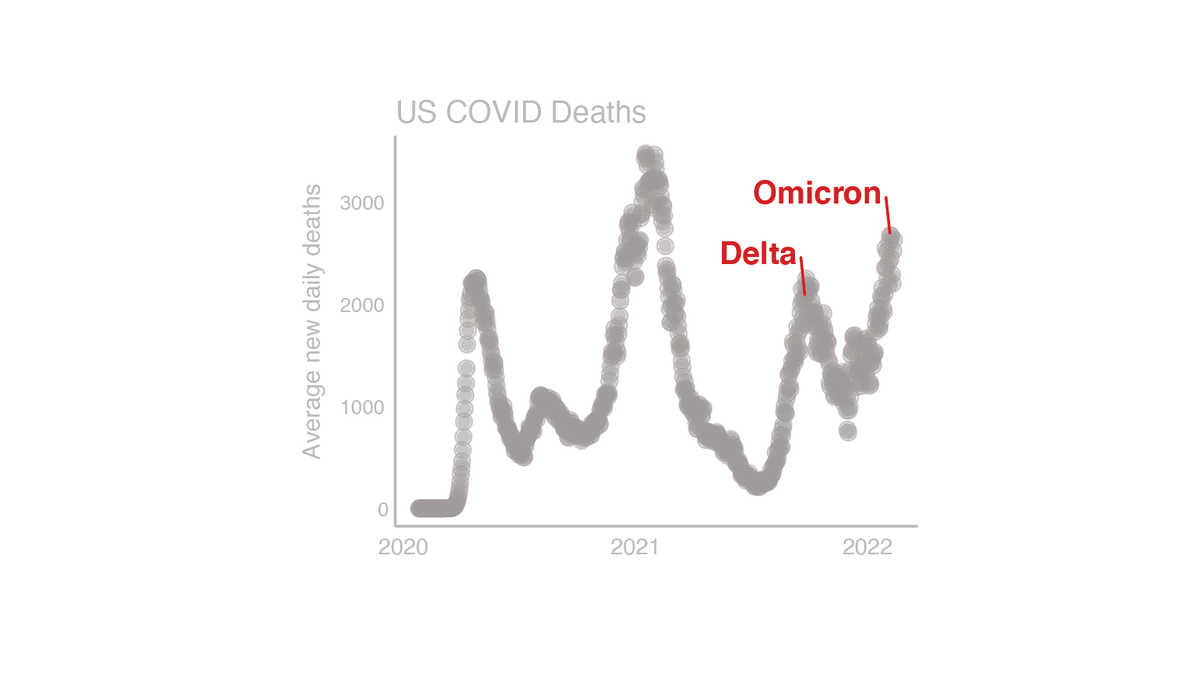In the US, “milder” omicron is killing more people per day than the worst of delta

While COVID cases are thankfully falling in the US, omicron, despite being “milder,” continues to kill more people per day in the US than the worst day of the delta surge. Why is this happening?

Omicron is "milder" than delta, but that doesn't mean it's the common cold
When the news broke from South Africa that a new, highly transmissible variant was detected, people were understandably alarmed. Delta was already folds more contagious than the original SARS-CoV-2 variant, and it was shocking to see the virus mutate to become even more contagious.
Original Variant versus Delta Variant

Visualization of the difference in exponential growth between the original variant (left) and the delta variant (right). Each red dot represents one infected person. Ro (pronounced R-naught), is a measure of contagiousness and represents how many people each infected person goes on to infect, on average. Estimates for Ro for the original variant and delta variant are based on this CDC update. I have not yet come across a good Ro estimate for omicron, so didn’t include that in the plot, but we know it’s much, much higher than delta based on the fact that it so rapidly became the dominant variant around the world.
While the extreme contagiousness of omicron was definitely bad news, one piece of good news began to emerge as well: on average, omicron doesn’t cause quite as severe disease as delta. One study (a preprint, not yet peer-reviewed) compared outcomes of people infected with omicron versus delta: after controlling for vaccination status and demographic factors, the preprint found that the risk of hospitalization from omicron was half that of delta, the risk of needing ICU-level care was a quarter that of delta, and the risk of death was a tenth that of delta (Source: preprint; plain language summary: Healthline).
"Milder" doesn't mean mild
However, this silver lining quickly became a source of confusion, fueled by several converging factors. First, people seemed to forget that delta was already more severe than prior variants. The risk of hospitalization from delta is double that of the alpha variant. So comparing omicron to delta, calling it milder, fails to remind people that delta was already “extra” severe.
Anecdotes aren't enough
Second, omicron’s extreme contagiousness meant millions of people were getting infected all at the same time. As has been true of every single variant, some people who get COVID only have mild symptoms (fevers, chills, runny nose, etc), some have moderate symptoms (trouble breathing, etc.), some end up in the hospital (need extra oxygen to help them breathe, or complications from other things caused by COVID like blood clots), some end up in the ICU (need critical level of care), and some die. The likelihood of ending up in these different categories changes based on which variant is causing the infection as well as each person’s vaccination status, prior infection(s), age, and other factors. But it’s important to note that it’s always been true that some people who get COVID will have a mild case. This wasn’t new with omicron. (And we should mention that even mild cases can lead to long-COVID, which is not a mild disease).
But one thing that did change with omicron was the sheer number of people getting infected all at the same time. For many people who hadn’t yet had a personal brush with COVID, omicron gave them a front row seat. All of a sudden everybody knew multiple people who were infected, and many people experienced infection firsthand. For those who had only heard about what COVID is like remotely, finally they were experiencing the disease for themselves. And as with every prior variant, some of those people had mild cases, some had moderate cases, some had severe cases, and some died.
Because omicron gave so many people personal experiences with COVID, now millions were in the position to commit the anecdotal fallacy. This logical fallacy takes limited personal experiences (anecdotes) and makes broad sweeping conclusion from it. An example would be someone who says: “My whole family got omicron and it was just a fever and a sore throat for a few days! This is no worse than the common cold and everyone is overreacting.” Add to this the fact that omicron truly does send a lower percentage of people to hospital than delta and the word “mild” was splashed all over the news, and you have a recipe for confusion. It’s true that omicron (on average) causes less severe disease than delta, it’s true that many people have had mild cases from omicron, but it’s also true that omicron has sent hundreds of thousands of people to the hospital and is currently killing more people per day in the US than the delta variant ever did. All of these things are true at the same time. What’s not true is the idea that omicron is the same as the common cold: the common cold doesn’t overwhelm hospitals. If some people experienced omicron as a cold, that’s wonderful. But to take that limited experience and assume omicron is therefore “mild” for everyone is fallacious. One person or family’s “mild experience” doesn’t capture the full spectrum of disease caused by omicron: that’s not enough data.
Deaths lag behind cases
Finally, the third reason some were confused over the severity of omicron was the fact that deaths lag behind cases. At the beginning of the omicron wave in the US, deaths were not increasing, and some took this as evidence that omicron wasn’t causing severe disease. But in reality, not enough time had passed to see the impact of omicron on deaths: increases in deaths always lags behind cases by a few weeks. By January the increase in deaths started to emerge, and by February, the daily number of deaths from omicron in the US surpassed the peak of the summer’s delta surge.
If you multiply a small number by a very big number, you get a big number
Now, the math. The reason behind the increased deaths per day from omicron is simple: while the risk of hospitalization and death for each individual infection is lower for omicron than delta, omicron has caused way more infections per day than delta ever caused. As a hypothetical example using easy numbers, imagine there are 1 million infections from virus O, and 200,000 infections from virus D. Now let’s say the hospitalization rate is 5% for virus O and 10% and virus D. Even though the hospitalization rate for virus O is lower, it will cause more overall hospitalizations (1 million x 5% = 50k hospitalizations) than virus D (200,000 x 10% = 20k hospitalizations). While these are not the precise numbers for omicron and delta, the same concept applies and explains why omicron has overwhelmed hospitals and broke the US record for hospitalizations, and why currently more people in the US are dying per day from COVID than the worst day of the delta surge.
In conclusion, omicron causes mild infection in some, it kills others, and it’s so contagious it’s ridiculous. There has been a lot of confusion over the word “mild,” and while omicron does cause less severe disease than delta on average, it is by no means a “mild virus.”




